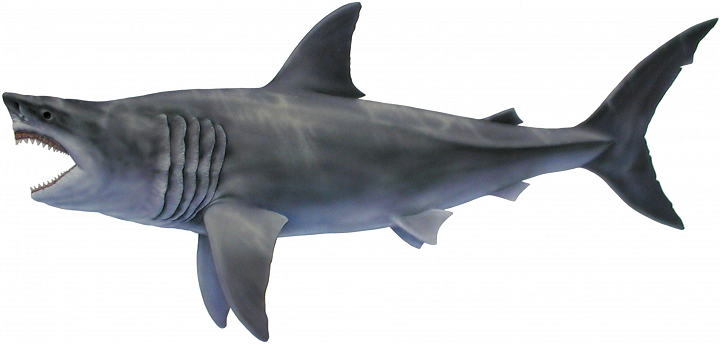A few years ago, researchers from the University of Florida conducted a case study about their National Science Foundation-funded program iDigFossils, featuring curriculum on subjects like evolution and climate change and using 3D printed tooth fossil replicas as a tool. For example, middle and high school students in Florida and California learned how scientists use data from current sharks to better understand the ancient megalodon, which existed in our oceans over 2 million years ago. But one lesson gone wrong ended up revealing more than the researchers had bargained for—a bigger size estimate for the megalodon. A trio of researchers recently published a study that explains a more reliable way of estimating the gigantic creature’s size by the width of its teeth, and that instead of measuring 50-60 feet long, it was actually closer to 65 feet, or almost the length of two school buses.
At the time of the educational case study, researcher Victor Perez, the lead author of this new study, was a doctoral student with the Department of Geological Sciences at the Florida Museum of Natural History, and was helping students with a math exercise that used 3D printed replicas of fossilized megalodon teeth and a set of common equations, based on the height of the teeth, to estimate the body length of a modern day shark. Unfortunately, calculations for the same shark were all over the map, and Perez realized there was a problem.

When megalodon was first described as a species, scientists thought it was the direct ancestor of the great white shark. Although the two have similar teeth and feeding habits, they last shared a common ancestor about 60 million years ago, Perez said. Image courtesy of Tim Scheirer, Calvert Marine Museum.
The only known remains of the megalodon, which means “big tooth,” are a few fossilized vertebrae and teeth, so scientists working to estimate its size haven’t had much to work with. But, while the lightweight cartilage that the megalodon and other sharks are made of decomposes quickly, Perez said that tooth enamel preserves well, calling it “probably the most structurally stable thing in living organisms.”
While the megalodon belongs to a different family than the great white shark, the latter is typically used as a stand-in for the former when it comes to estimating length, as both had similar lifestyles and triangular, serrated teeth befitting a predator. These estimations rely on the relationship between the size of the animal’s tooth to its total body length, and researchers must identify a fossil tooth’s former position in a megalodon jaw. However, the size and shape of shark teeth are different depending on their location in the mouth, and most megalodon teeth are found alone, so the location is hard to judge properly.

Sharks’ jaws are made of cartilage, the same tissue found in humans’ noses and ears. Cartilage decomposes quickly, but tooth enamel is extremely durable and preserves well.
In 2015, fossil collector Gordon Hubbell made an important donation to the Florida Museum: an almost complete set of teeth from the same megalodon. The teeth were CT scanned and the resulting models were put online, and Perez worked with Megan Higbee Hendrickson, a middle school teacher at the Academy of the Holy Names in Tampa, to use the teeth in lesson plans.
Hendrickson explained, “We decided to have the kids 3D-print the teeth, determine the size of the shark and build a replica of its jaw for our art show.
“Victor was an amazing role model for the kids. He is the personification of a young scientist that followed his childhood interest and made a career out of it. So many of these kids had never worked with or spoken to a scientist who respected their point of view and was willing to answer their questions.”
The two designed a lesson were students matched a tooth to its jaw position, looked up the equation that went with it, measured the tooth from the tip of its crown to where the crown meets the root, and put that number into the equation. The lesson plan was so successful, Perez took it to high school students at Delta Charter High School in California, complete with the full set of megalodon teeth, but this is where things went awry. Obviously, small variations in the measurements are expected, but the students were finding estimates that differed more than 100 feet. The further a tooth was away from the front of the jaw, the bigger the estimate.

Vertebrate paleontologist Victor Perez began collecting fossils when he was 6 years old. After completing his PhD, he became assistant curator at the Calvert Marine Museum where he first became fascinated with megalodon as a child. “It definitely feels a little surreal,” he said.
“I was going around, checking, like, did you use the wrong equation? Did you forget to convert your units? But it very quickly became clear that it was not the students that had made the error,” explained Perez, now the assistant curator of paleontology at the Calvert Marine Museum in Maryland. “It was simply that the equations were not as accurate as we had predicted.”
He explained the results of the lesson plan in a fossil community newsletter, and Teddy Badaut, an avocational paleontologist in France, reached out with an idea—measure the width of the tooth, instead of the height. He thought this might be more accurate, as previous research posited that a shark’s jaw, which was proportional to its body length, would limit the width of the tooth and thus offer a more precise measurement. Ronny Maik Leder, a postdoctoral researcher at the Florida Museum at the time, partnered with Perez to come up with a new set of equations based on the set of donated megalodon teeth.
Perez explained, “We could actually sum up the width of the teeth and get an even better approximation of the jaw width.”

Megalodon teeth can be up to 7 inches long and were specialized for feeding on large, fleshy prey, like whales and dolphins.
In total, the researchers analyzed sets of fossil teeth from 11 different sharks, from five different species, including the megalodon and modern great white sharks. They came up with a model for how wide a tooth was in relation to the jaw for a species by just measuring the combined width of each tooth in a row.
“I was quite surprised that indeed no one had thought of this before. The simple beauty of this method must have been too obvious to be seen. Our model was much more stable than previous approaches,” said Leder, who’s now the director of the Natural History Museum in Leipzig, Germany. “This collaboration was a wonderful example of why working with amateur and hobby paleontologists is so important.”

Excavated from North Carolina, these 46 fossils comprise the most complete set of megalodon teeth found. Students printed 3D replicas of the teeth and used them to estimate megalodon’s length. Florida Museum photo by Jeff Gage.
Because individual sharks do vary in size, Perez explained that these methods will still have an error range of roughly ten feet when applied to the larger animals. Additionally, they still don’t know exactly how wide the megalodon’s jaw was, because some species of shark have gaps between each tooth, while other species have overlapping teeth. Perez says that this is helpful in teaching students about the nature of science, stating that there “are still unanswered questions.”
“Even though this potentially advances our understanding, we haven’t really settled the question of how big megalodon was,” he said. “There’s still more that could be done, but that would probably require finding a complete skeleton at this point.”
3D scanning and printing have often been used to help us uncover secrets from the past, and the technologies are also very helpful in offering students, researchers, and other people a closer look at our history.
(Source: Florida Museum of Natural History / Photos: Florida Museum by Kristen Grace unless otherwise noted)
Subscribe to Our Email Newsletter
Stay up-to-date on all the latest news from the 3D printing industry and receive information and offers from third party vendors.
Print Services
Upload your 3D Models and get them printed quickly and efficiently.
You May Also Like
Heating Up: 3D Systems’ Scott Green Discusses 3D Printing’s Potential in the Data Center Industry
The relentless rise of NVIDIA, the steadily increasing pledges of major private and public investments in national infrastructure projects around the world, and the general cultural obsession with AI have...
3DPOD 260: John Hart on VulcanForms, MIT, Desktop Metal and More
John Hart is a Professor at MIT; he´s also the director of the Laboratory for Manufacturing and Productivity as well as the director of the Center for Advanced Production Technologies....
Etsy Design Rule Change Reduces Selection of 3D Printed Goods
Online marketplace Etsy has implemented a rule change requiring all 3D printed goods on the site to be original designs. The update to the site’s Creativity Standards states, ¨Items produced using...
E-Beam OEM Wayland Additive Partners with USC Racing to 3D Print Titanium Exhaust Collector
Every year, standards organization SAE International holds a competition called Formula SAE, in which students from both undergraduate and graduate programs design, build, and race small formula-style race cars. For...

































